Simultaneous Effects of Perlite Fine Aggregate and Silica Fume on the Physical Properties of Lightweight Cement Mortars
Abstract
1. Introduction
2. Materials and Methodology
2.1. Materials
2.2. Concrete Mix Proportion
2.3. Sampling and Testing of Mortar
3. Experimental Results and Discussion
3.1. Flowability
3.2. Compressive Strength
3.3. Flexural Strength
3.4. Density
3.5. Water Absorption
3.6. Thermal Conductivity
3.7. Relationship Between Thermal Conductivity, Density, and Compressive Strength
4. Conclusions
- At 56 days, the compressive strength of mixes Pe-20% to Pe-100% showed average reductions of 17%, 39%, 56%, 74%, and 78%, respectively, compared with the reference mix. This decrease reflects the lower density of the perlite aggregate, where higher replacement levels lead to reduced strength. In contrast, mixes containing silica fume (SF-20% to SF-100%) exhibited smaller reductions of 18%, 29%, 52%, 61%, and 71%, demonstrating that silica fume helped mitigate strength loss and contributed to improved performances at later stages.
- In the flexural strength tests, mixes Pe-20% to Pe-100% showed reductions of 6%, 6%, 11%, 29%, and 40%, respectively, relative to the reference mix, with strength decreasing as perlite content increased. A similar trend was observed in the silica fume mixes (SF-20% to SF-100%), which exhibited reductions of 9%, 13%, 28%, and 36% with higher perlite replacement.
- Increasing the perlite content in the mortar resulted in a progressive reduction in density. The greatest decrease was observed in Pe-100%, with a 57% reduction, reflecting the inherently low density of the perlite aggregate. The average density reductions for mixes Pe-20% to Pe-100% were 16%, 33%, 43%, 47%, and 57%, respectively. For the silica fume mixes (SF-control to SF-100%), the corresponding reductions were 15%, 33%, 43%, 46%, and 55%.
- Water absorption increased with a higher perlite content, reflecting the very high absorption capacity of the perlite aggregate. The maximum increase was observed in Pe-100%, which recorded a 327% rise compared to the reference mix. In contrast, SF-100% showed a lower increase of 181%, as silica fume contributed to reducing absorption. The absorption increments for mixes Pe-20% to Pe-100% were 16%, 80%, 175%, 219%, and 327%, respectively, while those for mixes SF-20% to SF-100% were 18%, 58%, 78%, 94%, and 181%, respectively.
- Thermal conductivity decreased as the amount of perlite aggregate increased, due to the formation of additional voids in the mortar. The greatest reduction was observed in Pe-100%, which showed an 82% decrease compared with the reference mix. The average reductions for mixes Pe-20% to Pe-100% were 37%, 63%, 72%, and 82%, respectively. Similarly, the silica fume mixes (SF-20% to SF-100%) also exhibited progressively lower conductivity with increasing perlite content, with reductions of 37%, 63%, 71%, 75%, and 81%, respectively, relative to the reference.
- MixSF-60% can be regarded as a suitable optimal balance under the present study conditions, as it combines a compressive strength of 4.4 MPa with a low density of 1089 kg/m3 and a reduced thermal conductivity of 0.28 W/(m·K). Although other mixtures, such as SF-40%, also showed good performance, SF-60% offered the most favorable compromise between mechanical strength and thermal insulation. Ultimately, the choice of mix may be adjusted in practice depending on the specific performance requirements of a given application.
Author Contributions
Funding
Institutional Review Board Statement
Informed Consent Statement
Data Availability Statement
Acknowledgments
Conflicts of Interest
References
- Mahmmod, L.M.R.; Dulaimi, A.; Bernardo, L.F.A.; Andrade, J.M.d.A. Characteristics of Lightweight Concrete Fabricated with Different Types of Strengthened Lightweight Aggregates. J. Compos. Sci. 2024, 8, 144. [Google Scholar] [CrossRef]
- Shcherban’, E.M.; Stel’makh, S.A.; Mailyan, L.R.; Beskopylny, A.N.; Mailyan, A.L.; Shcherban’, N.; Chernil’nik, A.; Elshaeva, D. Composition and Properties of Lightweight Concrete of Variotropic Structure Based on Combined Aggregate and Microsilica. Buildings 2025, 15, 346. [Google Scholar] [CrossRef]
- Bakhshi, M.; Dalalbashi, A.; Soheili, H. Energy dissipation capacity of an optimized structural lightweight perlite concrete. Constr. Build. Mater. 2023, 389, 131765. [Google Scholar] [CrossRef]
- Kumar, P.; Pasla, D.; Saravanan, T.J. Self-compacting lightweight aggregate concrete and its properties: A review. Constr. Build. Mater. 2023, 375, 130861. [Google Scholar] [CrossRef]
- Agrawal, Y.; Gupta, T.; Sharma, R.; Panwar, N.L.; Siddique, S. A comprehensive review on the performance of structural lightweight aggregate concrete for sustainable construction. Constr. Mater. 2021, 1, 39–62. [Google Scholar] [CrossRef]
- Erdem, T.K.; Meral, Ç.; Tokyay, M.; Erdoğan, T. Use of perlite as a pozzolanic addition in producing blended cements. Cem. Concr. Compos. 2007, 29, 13–21. [Google Scholar] [CrossRef]
- Lam, T.V.; Vu, D.T.; Dien, V.K.; Bulgakov, B.; Anatolyevna, K.E. Properties and thermal insulation performance of light-weight concrete. Mag. Civ. Eng. 2018, 8, 173–191. [Google Scholar]
- Smoczkiewicz-Wojciechowska, A.; Sybis, M.; Mądrawski, J.; Kostrzewski, W. The study on possible applications of lightweight concrete based on waste aggregate in terms of compressive strength and thermal insulation properties. Pol. J. Environ. Stud. 2022, 31, 833–841. [Google Scholar] [CrossRef]
- Ding, X.; Yu, J.; Lin, J.; Chen, Z.; Li, J. Experimental investigations of prefabricated lightweight self-insulating foamed concrete wall panels. Structures 2024, 61, 106001. [Google Scholar] [CrossRef]
- Ibrahim, M.; Ahmad, A.; Barry, M.S.; Alhems, L.M.; Mohamed Suhoothi, A. Durability of structural lightweight concrete containing expanded perlite aggregate. Int. J. Concr. Struct. Mater. 2020, 14, 50. [Google Scholar] [CrossRef]
- Tapan, M.; Engin, C. Effect of expanded perlite aggregate size on physical and mechanical properties of ultra lightweight concrete produced with expanded perlite aggregate. Period. Polytech. Civ. Eng. 2019, 63, 845–855. [Google Scholar] [CrossRef]
- Hasana, A.S.M.; Nora, N.M.; Jamaludina, A.H.; Ruslana, A.K.; Osmana, N.M.; Sooriab, S.Z.; Saliaha, S.N.M.; Fauzia, M.A. Control Strength Lightweight Mortar made by Recycled Concrete Aggregate and Expanded Perlite. J. Kejuruter. 2024, 36, 2287–2299. [Google Scholar] [CrossRef]
- Sengul, O.; Azizi, S.; Karaosmanoglu, F.; Tasdemir, M.A. Effect of expanded perlite on the mechanical properties and thermal conductivity of lightweight concrete. Energy Build. 2011, 43, 671–676. [Google Scholar] [CrossRef]
- Sengul, O.; Tasdemir, C.; Tasdemir, M.A. Influence of aggregate type on mechanical behavior of normal-and high-strength concretes. Mater. J. 2002, 99, 528–533. [Google Scholar]
- ASTM C 332; Standard Specification for Lightweight Aggregates for Insulating Concrete. ASTM International: West Conshohocken, PA, USA, 2009.
- Lura, P.; Bentz, D.P.; Lange, D.A.; Kovler, K.; Bentur, A. Pumice aggregates for internal water curing. In Proceedings of the International RILEM Symposium on Concrete Science and Engineering: A Tribute to Arnon Bentur, Evanston, IL, USA, 21–24 March 2004; pp. 22–24. [Google Scholar]
- Whwah, M.S.; Mahmmod, L.M.R.; Abdoulhaleem, H.H.; Dulaimi, A. Internal Curing Utilising Recycled Concrete Aggregate: A Sustainable Approach for Improving High-Strength Concrete’s Performance. Arab. J. Sci. Eng. 2024, 50, 8061–8076. [Google Scholar] [CrossRef]
- Yu, L.-H.; Ou, H.; Lee, L.-L. Investigation on pozzolanic effect of perlite powder in concrete. Cem. Concr. Res. 2003, 33, 73–76. [Google Scholar] [CrossRef]
- ACI Committee 122. Guide to Thermal Properties of Concrete and Masonry Systems; ACI Committee: Farmington Hills, MI, USA, 2002. [Google Scholar]
- Asadi, I.; Shafigh, P.; Hassan, Z.F.B.A.; Mahyuddin, N.B. Thermal conductivity of concrete–A review. J. Build. Eng. 2018, 20, 81–93. [Google Scholar] [CrossRef]
- Benjeddou, O.; Ravindran, G.; Abdelzaher, M.A. Thermal and acoustic features of lightweight concrete based on marble wastes and expanded perlite aggregate. Buildings 2023, 13, 992. [Google Scholar] [CrossRef]
- Stratoura, M.C.; Lazari, G.-E.D.; Badogiannis, E.G.; Papadakis, V.G. Perlite and rice husk ash Re-use as fine aggregates in lightweight aggregate structural concrete—Durability assessment. Sustainability 2023, 15, 4217. [Google Scholar] [CrossRef]
- Yan, G.; Al-Mulali, M.Z.; Madadi, A.; Albaijan, I.; Ali, H.E.; Algarni, H.; Le, B.N.; Assilzadeh, H. Effect of perlite powder on properties of structural lightweight concrete with perlite aggregate. Struct. Eng. Mech. 2022, 84, 393–411. [Google Scholar]
- Al-Daraji, M.; Aljalawi, N. The effect of kevlar fibers on the mechanical properties of lightweight Perlite Concrete. Eng. Technol. Appl. Sci. Res. 2024, 14, 12906–12910. [Google Scholar] [CrossRef]
- Leong, G.W.; Mo, K.H.; Ibrahim, Z.; Radwan, M.K.; Ling, T.-C.; Sinoh, S.S. Lightweight cementitious composites incorporating fly ash cenospheres and perlite microspheres. Constr. Build. Mater. 2023, 404, 133226. [Google Scholar] [CrossRef]
- Saikiran, M.; Rajeshwari, C. The Effects of Natural Perlite Aggregate and Perlite Powder on the Properties of Structural Light-Weight Concrete. Innovations 2023, 74, 72–81. [Google Scholar]
- Panagiotopoulou, C.; Angelopoulos, P.; Kosmidi, D.; Angelou, I.; Sakellariou, L.; Taxiarchou, M. Study of the influence of the addition of closed-structure expanded perlite microspheres on the density and compressive strength of cement pastes. Mater. Today Proc. 2022, 54, 118–124. [Google Scholar] [CrossRef]
- Różycka, A.; Pichór, W. Effect of perlite waste addition on the properties of autoclaved aerated concrete. Constr. Build. Mater. 2016, 120, 65–71. [Google Scholar] [CrossRef]
- Alyousef, R.; Benjeddou, O.; Soussi, C.; Khadimallah, M.A.; Jedidi, M. Experimental study of new insulation lightweight concrete block floor based on perlite aggregate, natural sand, and sand obtained from marble waste. Adv. Mater. Sci. Eng. 2019, 2019, 8160461. [Google Scholar] [CrossRef]
- Leyton-Vergara, M.; Pérez-Fargallo, A.; Pulido-Arcas, J.; Cárdenas-Triviño, G.; Piggot-Navarrete, J. Influence of granulometry on thermal and mechanical properties of cement mortars containing expanded perlite as a lightweight aggregate. Materials 2019, 12, 4013. [Google Scholar] [CrossRef]
- Alexa-Stratulat, S.-M.; Taranu, G.; Toma, A.-M.; Olteanu, I.; Pastia, C.; Bunea, G.; Toma, I.-O. Effect of expanded perlite aggregates and temperature on the strength and dynamic elastic properties of cement mortar. Constr. Build. Mater. 2024, 438, 137229. [Google Scholar] [CrossRef]
- Tie, T.S.; Mo, K.H.; Alengaram, U.J.; Kaliyavaradhan, S.K.; Ling, T.-C. Study on the use of lightweight expanded perlite and vermiculite aggregates in blended cement mortars. Eur. J. Environ. Civ. Eng. 2022, 26, 3612–3631. [Google Scholar] [CrossRef]
- Jssem, M.; Fawzi, N.M. Effect of expanded perlite aggregate and silica fume on some properties of lightweight concrete. J. Eng. 2024, 30, 172–185. [Google Scholar] [CrossRef]
- Sai, K.; Srikanth, K.; Chaitra, K. Effect of natural perlite aggregate and its powder on properties of light weight concrete. Int. J. Adv. Agric. Sci. Technol. 2025, 12, 124–129. [Google Scholar]
- Sharma, B.; Sharma, R.; Bansal, P.P. Effect of fine aggregate replacement with expanded perlite and pumice on the development of lightweight concrete. Aust. J. Civ. Eng. 2022, 20, 115–129. [Google Scholar] [CrossRef]
- Kadela, M.; Małek, M.; Jackowski, M.; Kunikowski, M.; Klimek, A.; Dudek, D.; Rośkowicz, M. Recycling of tire-derived fiber: The contribution of steel cord on the properties of lightweight concrete based on perlite aggregate. Materials 2023, 16, 2124. [Google Scholar] [CrossRef]
- Naeem, B.Q.; Awad, H.K. Effect of Perlite Aggregate Replacement of Coarse Aggregate on the Behavior of SCC Exposed to Fire Flame by Using Different Cooling Methods. J. Eng. 2025, 31, 54–72. [Google Scholar] [CrossRef]
- Singh, M.; Garg, M. Perlite-based building materials—A review of current applications. Constr. Build. Mater. 1991, 5, 75–81. [Google Scholar] [CrossRef]
- IQS. Portland cement. In No. 5. Central Organization for Standardization and Quality Control, Iraq-Baghdad (2019); IQS: Bagdad, Iraq, 2019. [Google Scholar]
- IQS. Aggregate from natural sources for concrete and building construction. In No. 45. Central Organization for Standardization and Quality Control, Iraq-Baghdad (1984); IQS: Bagdad, Iraq, 1984. [Google Scholar]
- Tanyildizi, H.; Coskun, A. Performance of lightweight concrete with silica fume after high temperature. Constr. Build. Mater. 2008, 22, 2124–2129. [Google Scholar] [CrossRef]
- Suryanita, R.; Maizir, H.; Zulapriansyah, R.; Subagiono, Y.; Arshad, M.F. The effect of silica fume admixture on the compressive strength of the cellular lightweight concrete. Results Eng. 2022, 14, 100445. [Google Scholar] [CrossRef]
- ASTM C1437-20; Standard Test Method for Flow of Hydraulic Cement Mortar. ASTM International: West Conshohocken, PA, USA, 2020.
- Koksal, F.; Gencel, O.; Kaya, M. Combined effect of silica fume and expanded vermiculite on properties of lightweight mortars at ambient and elevated temperatures. Constr. Build. Mater. 2015, 88, 175–187. [Google Scholar] [CrossRef]
- Mazloom, M.; Ramezanianpour, A.A.; Brooks, J.J. Effect of silica fume on mechanical properties of high-strength concrete. Cem. Concr. Compos. 2004, 26, 347–357. [Google Scholar] [CrossRef]
- BSI. Testing hardened concrete, part 4: Compressive strength—Specification for testing machines. In BSI Standards Publication; The British Standards Institution Limited: London, UK, 2019. [Google Scholar]
- Sriwattanapong, M.; Sinsiri, T.; Pantawee, S.; Chindaprasirt, P. A study of lightweight concrete admixed with perlite. Suranaree J. Sci. Technol 2013, 20, 227–234. [Google Scholar]
- Whwah, M.S.; Al-Hussainy, H.A.; Dulaimi, A.; Bernardo, L.F.A.; Ribeiro, T.P. Investigation of the Effects of Water-to-Cement Ratios on Concrete with Varying Fine Expanded Perlite Aggregate Content. J. Compos. Sci. 2025, 9, 390. [Google Scholar] [CrossRef]
- Demir, İ.; Başpınar, M.S.; Doğan, C. Investigation of the Effects of Fly Ash, Fine Sand and Expanded Perlite on the Properties on Foam Concrete. Afyon Kocatepe Üniversitesi Fen Ve Mühendislik Bilim. Derg. 2022, 22, 1425–1433. [Google Scholar] [CrossRef]
- RILEM. Functional Classification of Lightweight Concretes: Recommendation LC2, 2nd ed.; RILEM: Paris, France, 1978. [Google Scholar]
- Ariyaratne, I.E.; Ariyanayagam, A.; Mahendran, M. Bushfire-resistant lightweight masonry blocks with expanded perlite aggregate. Fire 2022, 5, 132. [Google Scholar] [CrossRef]
- Al-Hdabi, A.; Al Nageim, H.; Seton, L. Performance of gap graded cold asphalt containing cement treated filler. Constr. Build. Mater. 2014, 69, 362–369. [Google Scholar] [CrossRef]
- Fang, X.; Garcia, A.; Winnefeld, F.; Partl, M.N.; Lura, P. Impact of rapid-hardening cements on mechanical properties of cement bitumen emulsion asphalt. Mater. Struct. 2016, 49, 487–498. [Google Scholar] [CrossRef]
- Aminpour, N.; Memari, A. Development of EPS light-weight concrete for 3D printing. Struct. Concr. 2025. [Google Scholar] [CrossRef]
- Newman, J.; Choo, B.S.X. Advanced Concrete Technology Set; Elsevier: Amsterdam, The Netherlands, 2003. [Google Scholar]
- Valore, R.C. Calculations of U-values of hollow concrete masonry. Concr. Int. 1980, 2, 40–63. [Google Scholar]
- Drozdzol, K. Thermal and mechanical studies of perlite concrete casing for chimneys in residential buildings. Materials 2021, 14, 2011. [Google Scholar] [CrossRef]
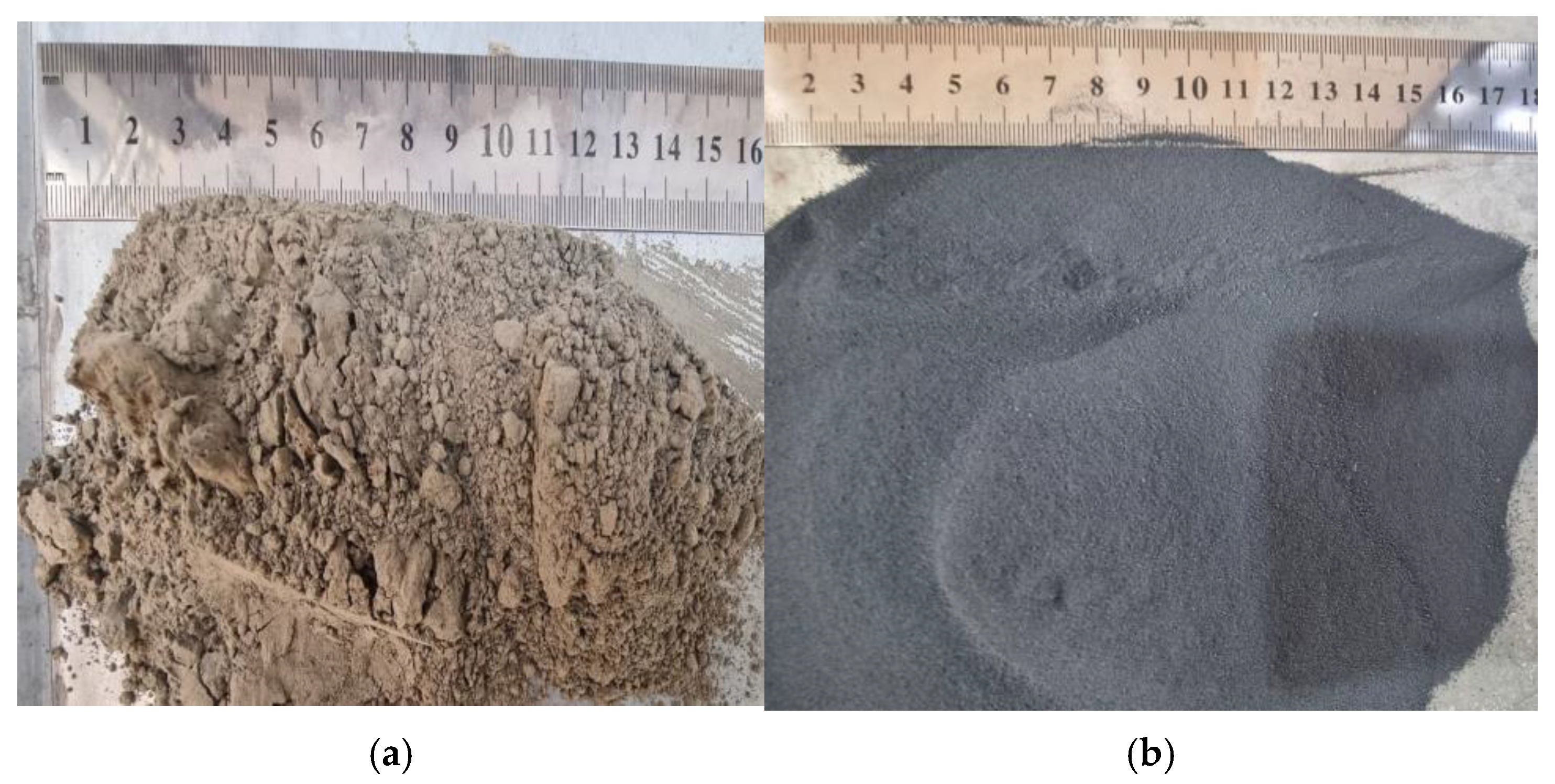
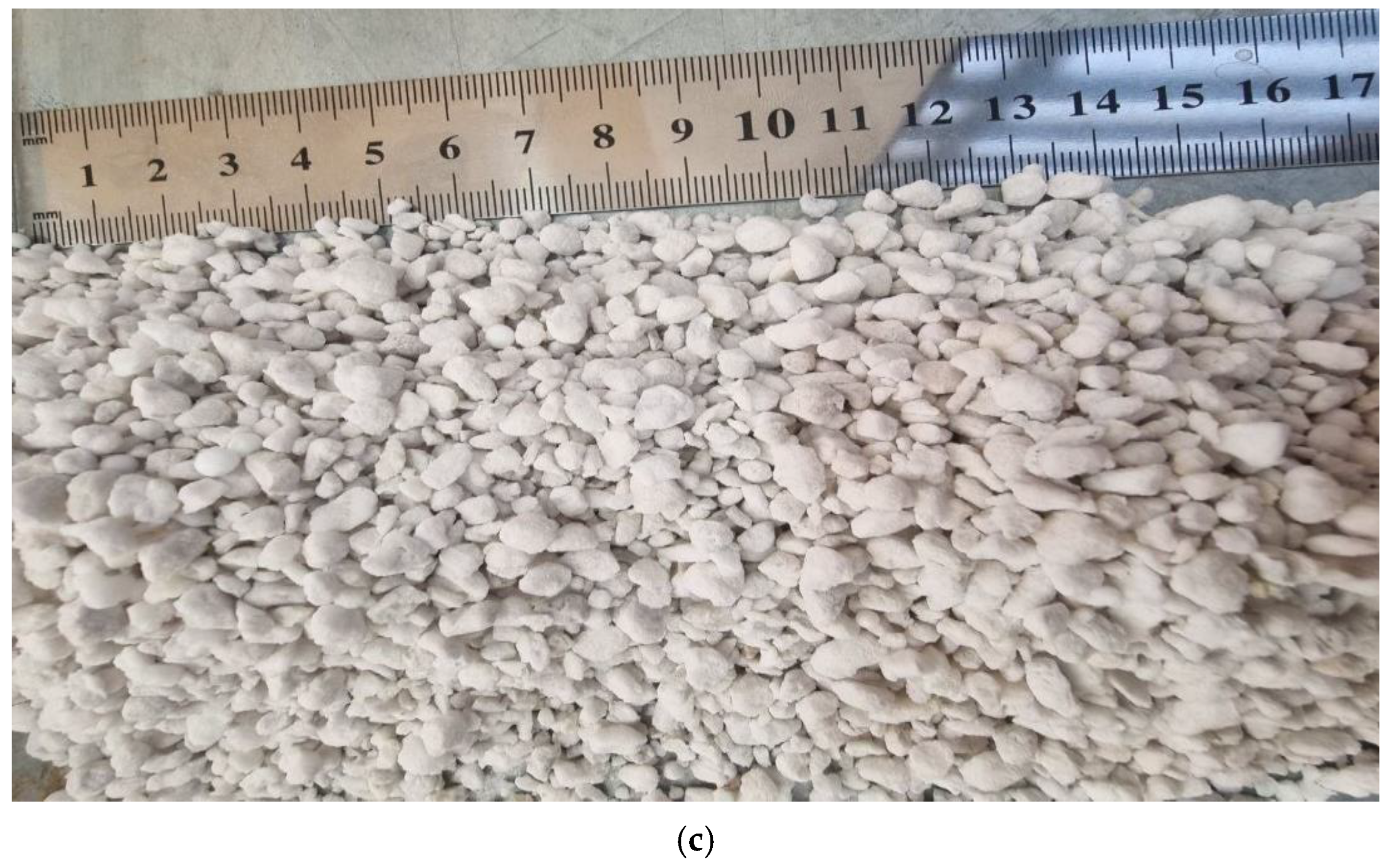
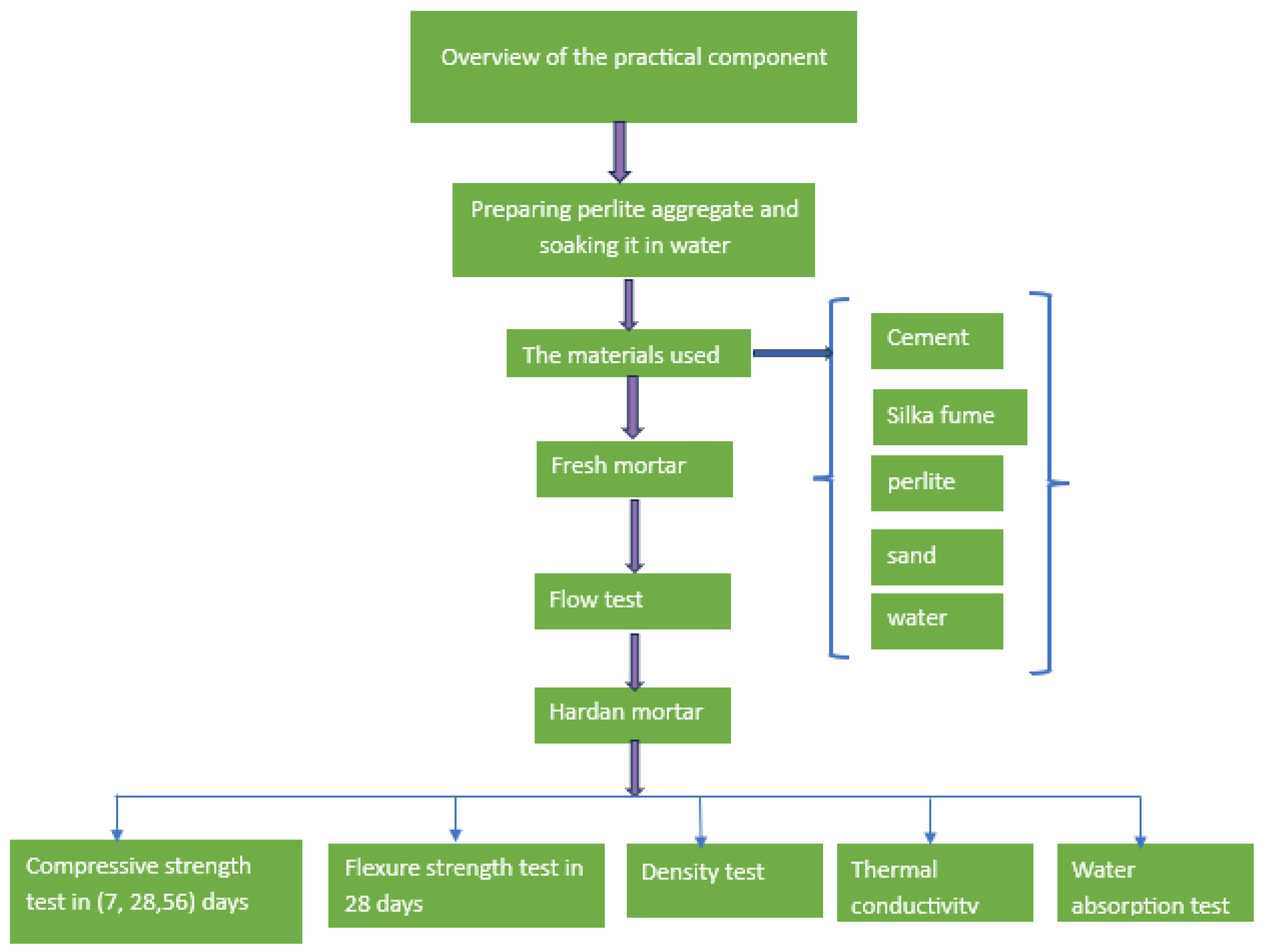
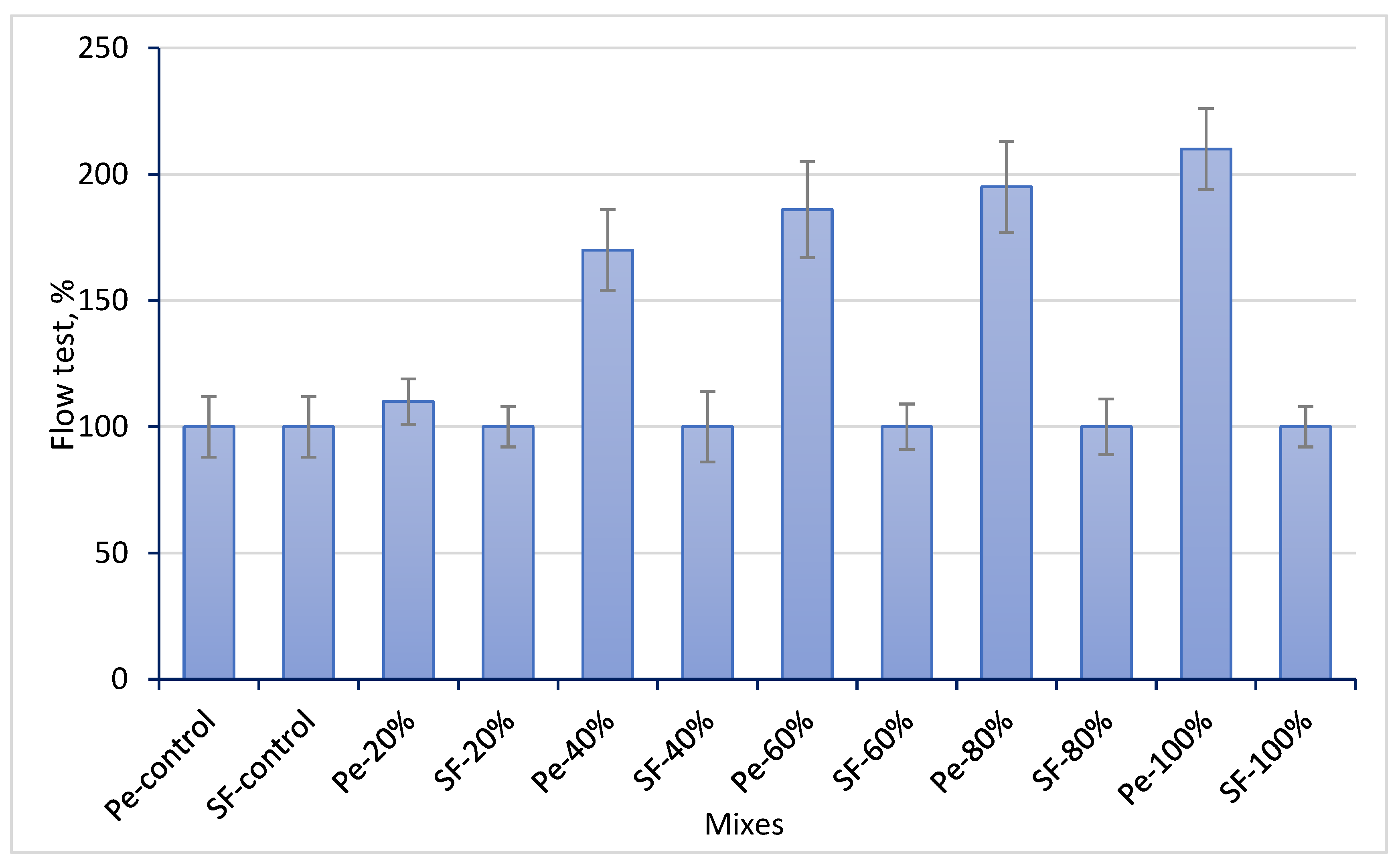

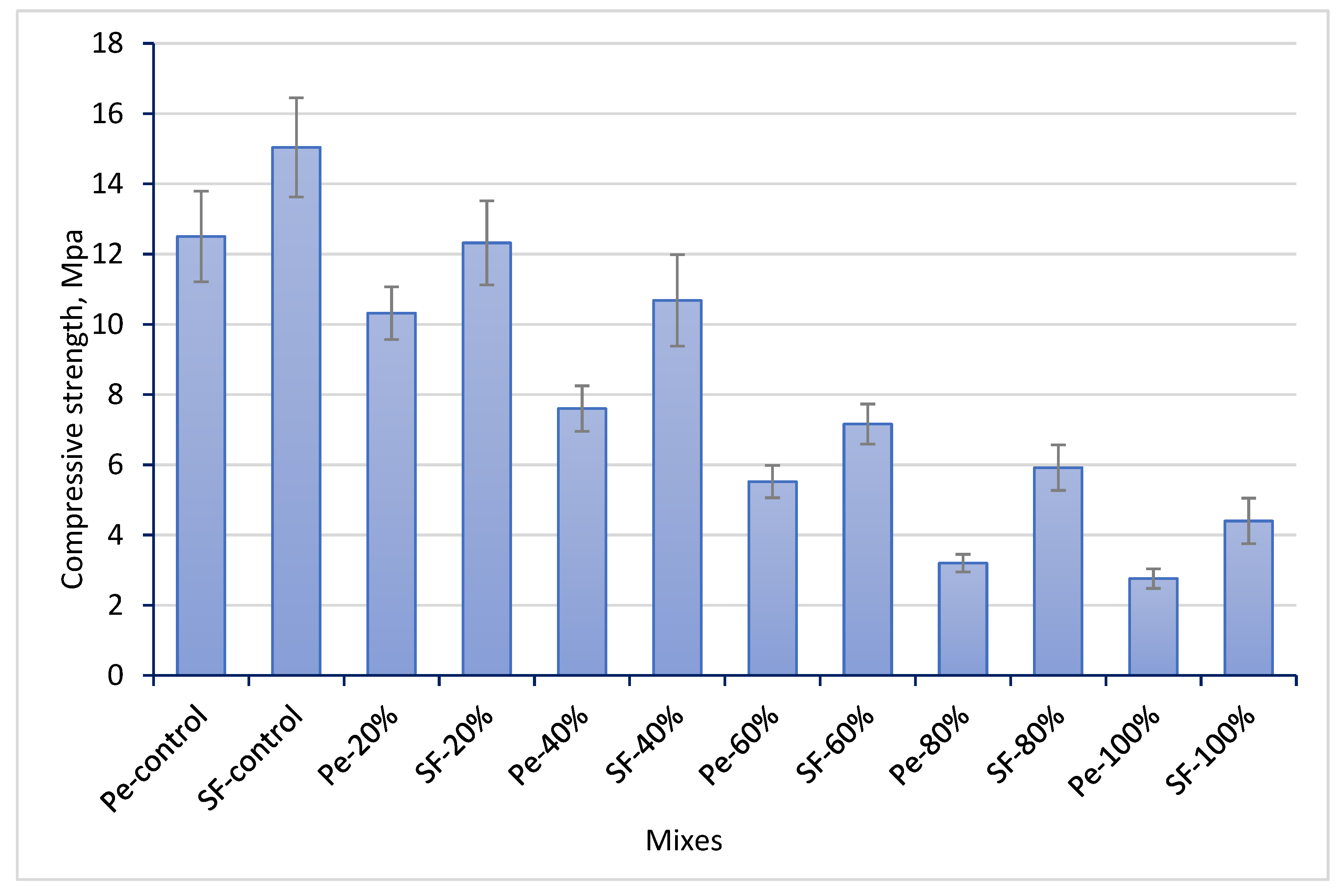
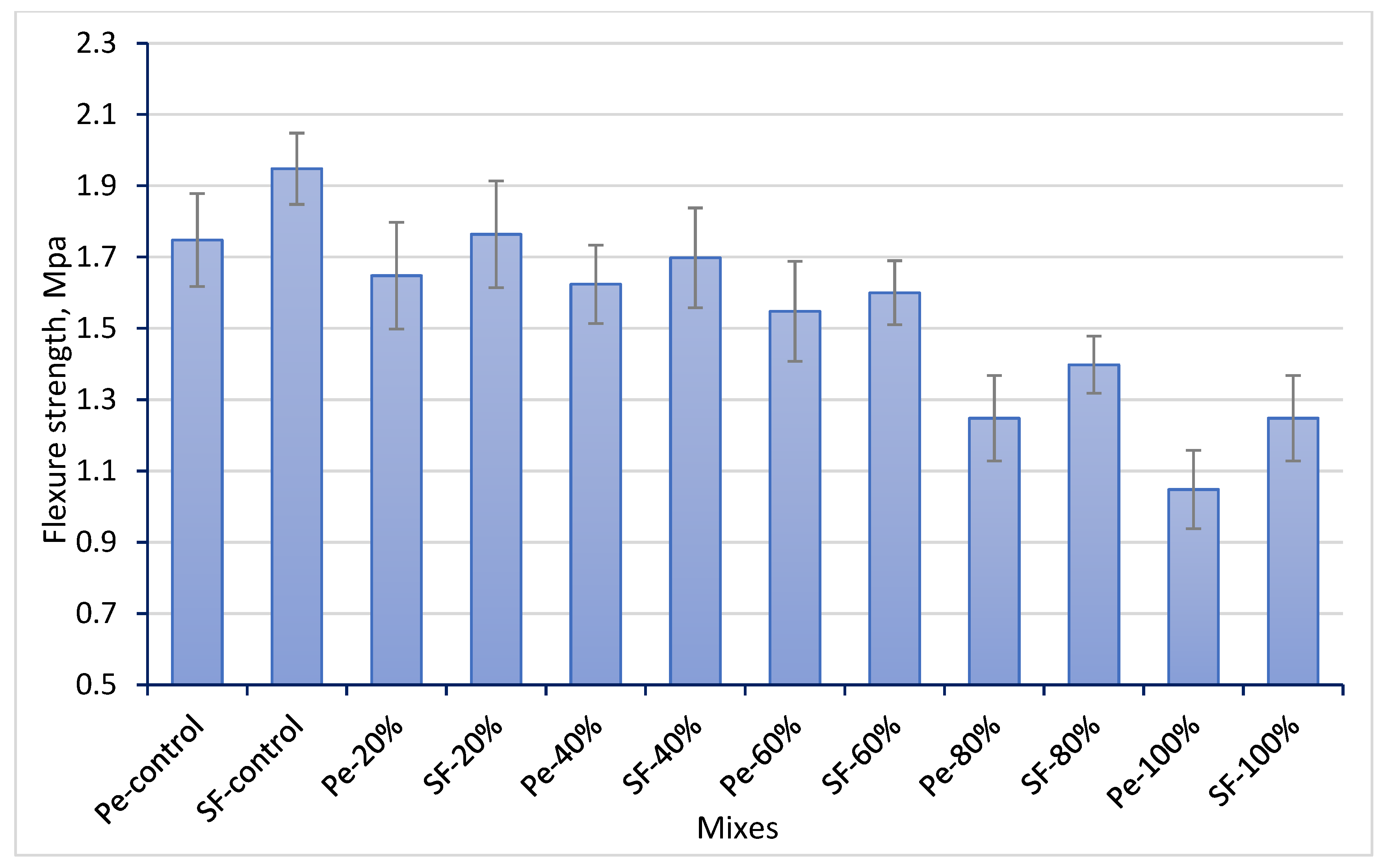
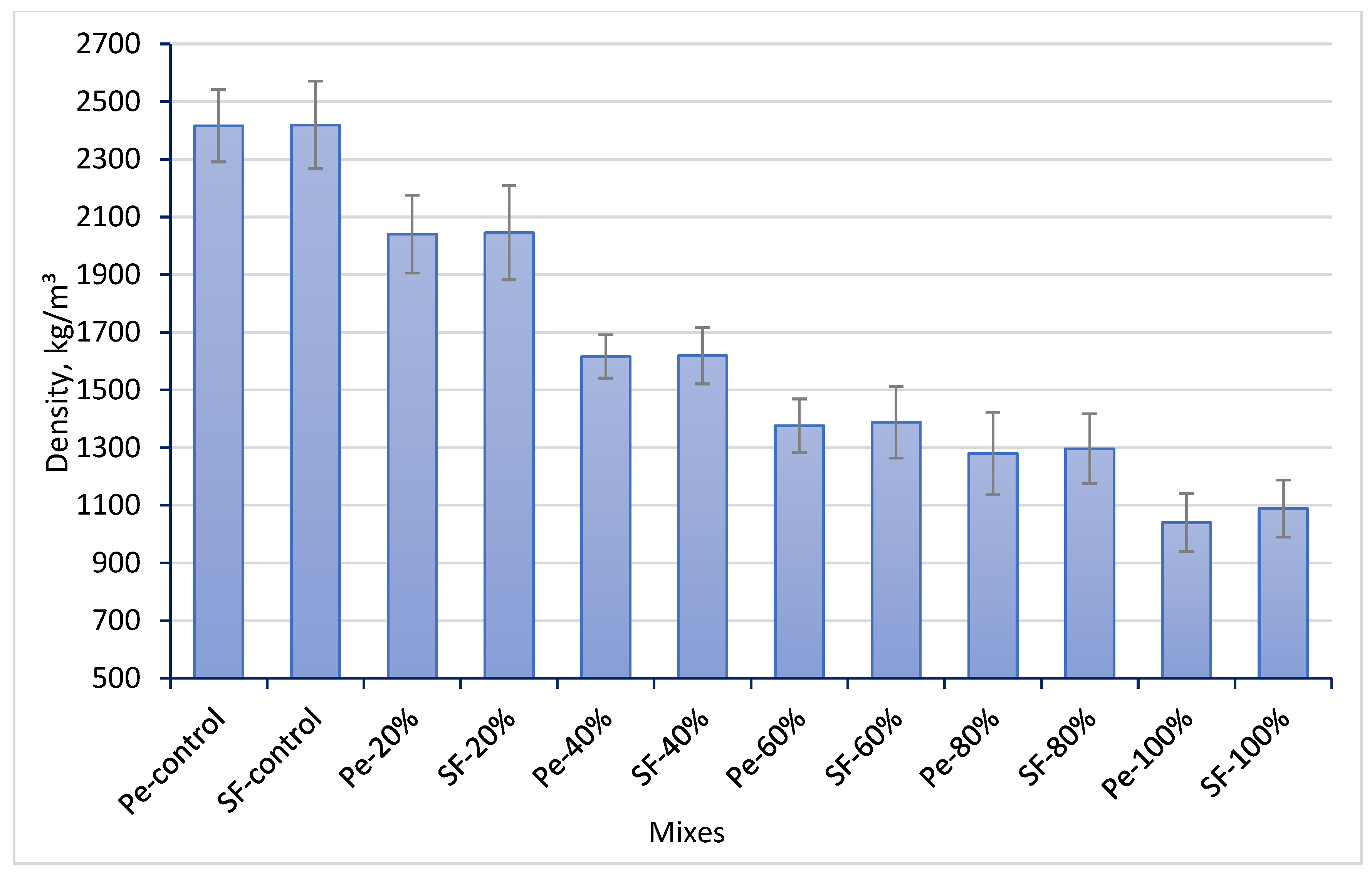
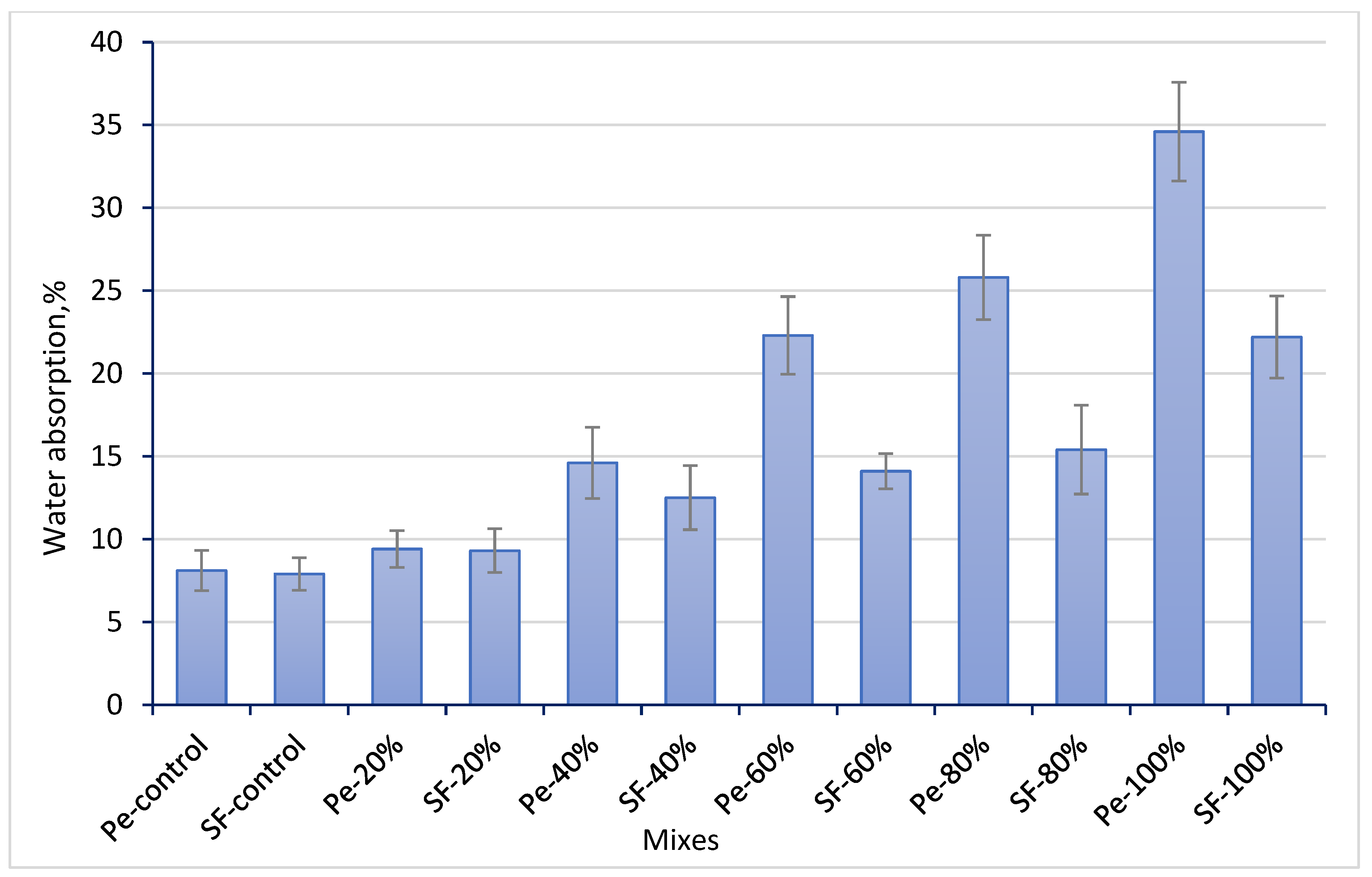
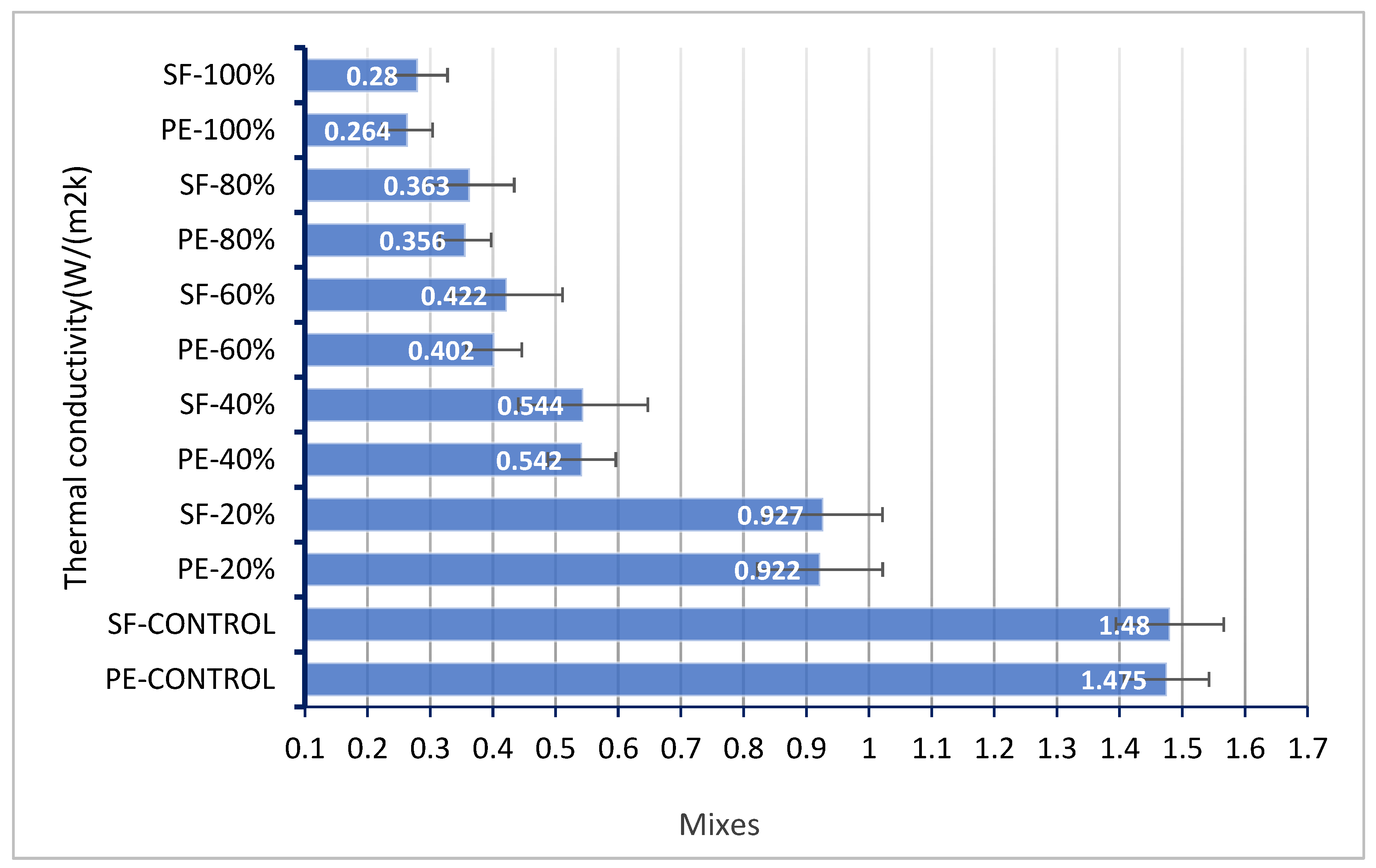
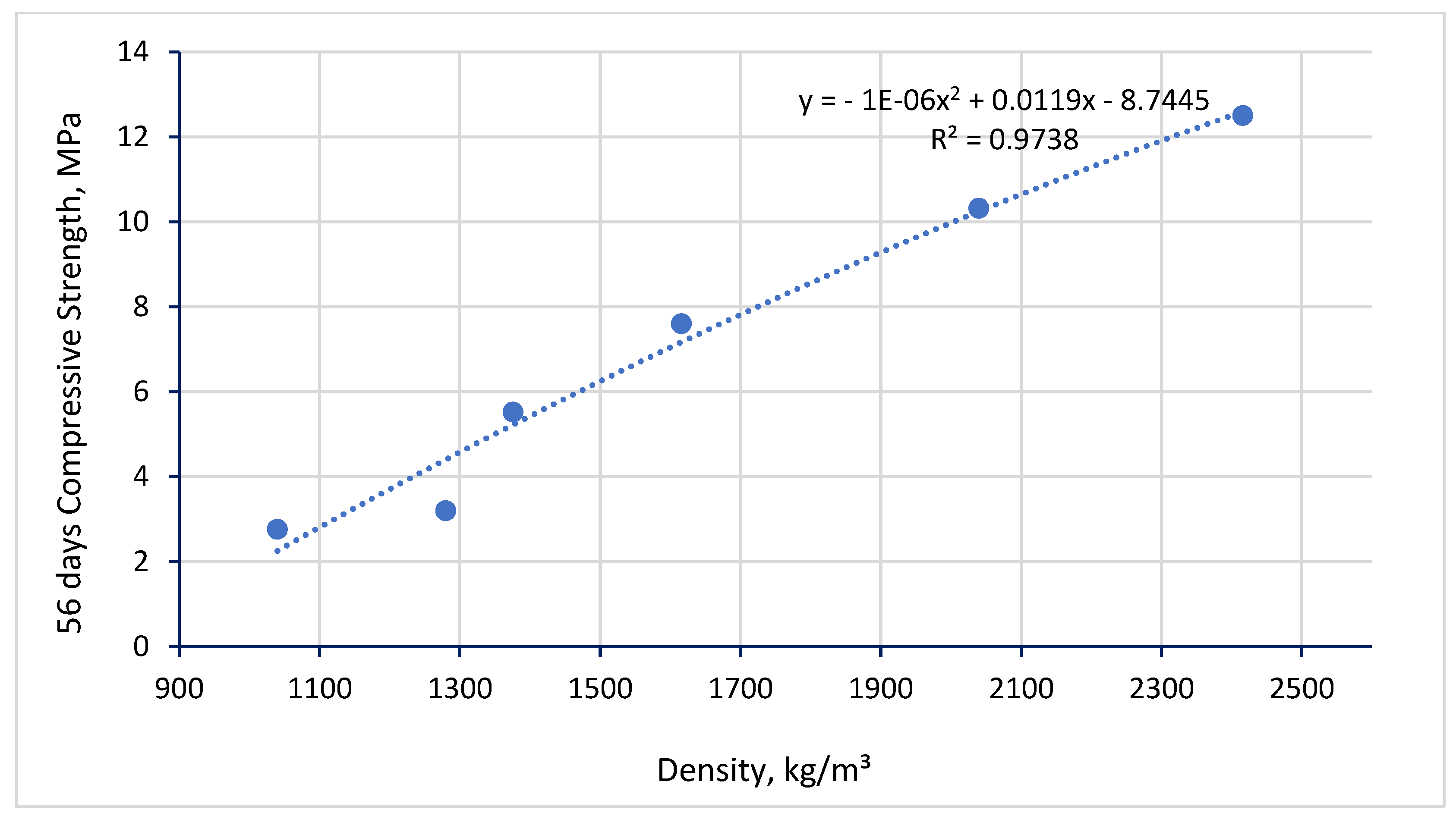

| Constituent/Property | Test Result | Limit According to I.Q.S No. 5.2019 |
|---|---|---|
| CaO, % | 62.15 | / |
| SiO2, % | 10.03 | / |
| Al2O3, % | 3.96 | / |
| Fe2O3, % | 3.62 | / |
| SO3, % | 2.23 | ≤2.8% |
| MgO, % | 2.31 | ≤5% |
| Loss on ignition (L.O.I), % | 2.04 | ≤4% |
| Insoluble residue (I.R), % | 0.84 | ≤1.5% |
| Lime saturation factor (L.S.F) | 0.79 | / |
| Setting time (Vicat method): | ||
| Initial setting time, min | 154 | ≥45 min |
| Final setting time, hrs:min | 3:22 | ≤10 h |
| Fineness (Blaine method), m2/kg | 335 | ≥230 m2/kg |
| Compressive strength, MPa: | ||
| 2 days | 17 | ≥10 MPa |
| 28 days | 45 | ≥32.5 MPa |
| Sieve Size | Cumulative Passing, % | Limit According to I.Q.S No. 45 | |
|---|---|---|---|
| Natural River Sand | Lightweight Perlite Aggregate | ||
| 10 mm | 100 | 0 | 100 |
| 4.75 mm | 96 | 0 | 95–100 |
| 2.36 mm | 87 | 77 | 80–100 |
| 1.18 mm | 60 | 21 | 50–85 |
| 600 µm | 44 | 5 | 25–60 |
| 300 µm | 18 | 4 | 5–30 |
| 150 µm | 0 | 0 | 0–10 |
| Silica Fume | Perlite | Water | Sand | Cement | Mixture |
|---|---|---|---|---|---|
| 0 | 0 | 168 | 1600 | 400 | Pe-control |
| 0 | 69 | 168 | 1280 | 400 | Pe-20% |
| 0 | 165 | 168 | 960 | 400 | Pe-40% |
| 0 | 260 | 168 | 720 | 400 | Pe-60% |
| 0 | 280 | 168 | 400 | 400 | Pe-80% |
| 0 | 322 | 168 | 0 | 400 | Pe-100% |
| 60 | 0 | 168 | 1600 | 340 | SF-control |
| 60 | 69 | 168 | 1280 | 340 | SF-20% |
| 60 | 165 | 168 | 960 | 340 | SF-40% |
| 60 | 260 | 168 | 720 | 340 | SF-60% |
| 60 | 280 | 168 | 400 | 340 | SF-80% |
| 60 | 322 | 168 | 0 | 340 | SF-100% |
| Mixture | 7 Days | 28 Days | 56 Days |
|---|---|---|---|
| Pe-control | 8.44 | 11.38 | 12.5 |
| Pe-20% | 6.2 | 7.64 | 10.32 |
| Pe-40% | 4.4 | 5.6 | 7.6 |
| Pe-60% | 2.8 | 3.4 | 5.52 |
| Pe-80% | 1.44 | 2.4 | 3.2 |
| Pe-100% | 1.08 | 2.08 | 2.76 |
| SF-control | 10.92 | 13.24 | 15.04 |
| SF-20% | 8.24 | 10.4 | 12.32 |
| SF-40% | 6.04 | 6.8 | 10.68 |
| SF-60% | 3.8 | 5.6 | 7.16 |
| SF-80% | 2.52 | 4 | 5.92 |
| SF-100% | 2.08 | 3.44 | 4.4 |
Disclaimer/Publisher’s Note: The statements, opinions and data contained in all publications are solely those of the individual author(s) and contributor(s) and not of MDPI and/or the editor(s). MDPI and/or the editor(s) disclaim responsibility for any injury to people or property resulting from any ideas, methods, instructions or products referred to in the content. |
© 2025 by the authors. Licensee MDPI, Basel, Switzerland. This article is an open access article distributed under the terms and conditions of the Creative Commons Attribution (CC BY) license (https://creativecommons.org/licenses/by/4.0/).
Share and Cite
Whwah, M.S.; Radhi, M.S.; Dulaimi, A.; Bernardo, L.F.A.; Ribeiro, T.P. Simultaneous Effects of Perlite Fine Aggregate and Silica Fume on the Physical Properties of Lightweight Cement Mortars. CivilEng 2025, 6, 51. https://doi.org/10.3390/civileng6030051
Whwah MS, Radhi MS, Dulaimi A, Bernardo LFA, Ribeiro TP. Simultaneous Effects of Perlite Fine Aggregate and Silica Fume on the Physical Properties of Lightweight Cement Mortars. CivilEng. 2025; 6(3):51. https://doi.org/10.3390/civileng6030051
Chicago/Turabian StyleWhwah, Mortada Sabeh, Mushtaq Sadiq Radhi, Anmar Dulaimi, Luís Filipe Almeida Bernardo, and Tiago Pinto Ribeiro. 2025. "Simultaneous Effects of Perlite Fine Aggregate and Silica Fume on the Physical Properties of Lightweight Cement Mortars" CivilEng 6, no. 3: 51. https://doi.org/10.3390/civileng6030051
APA StyleWhwah, M. S., Radhi, M. S., Dulaimi, A., Bernardo, L. F. A., & Ribeiro, T. P. (2025). Simultaneous Effects of Perlite Fine Aggregate and Silica Fume on the Physical Properties of Lightweight Cement Mortars. CivilEng, 6(3), 51. https://doi.org/10.3390/civileng6030051










